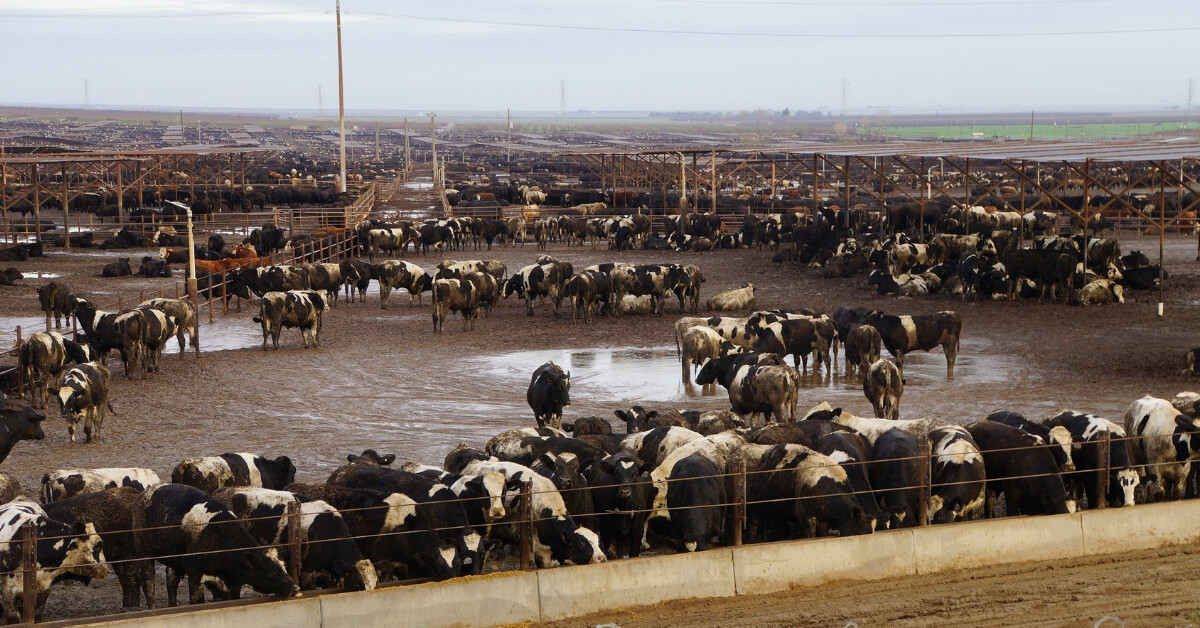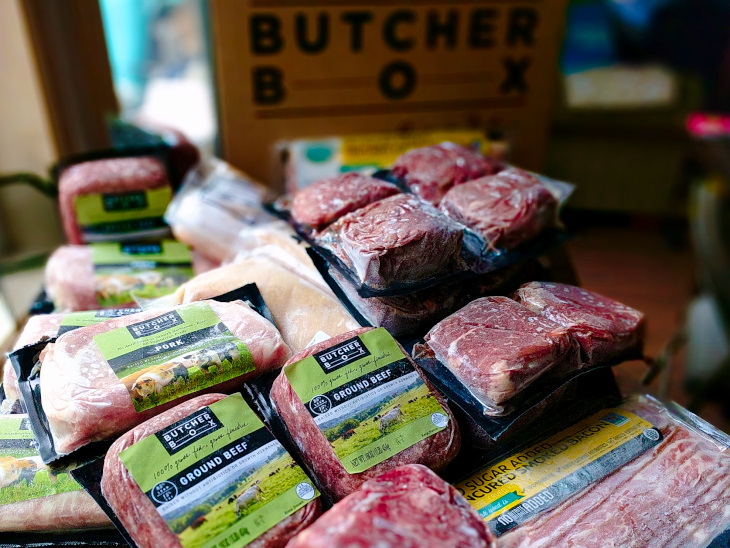I haven’t written a lot about what makes grass-fed beef better than conventional beef. I talked about it a little in a recent post series on healthy fats, and I talked about it a bit more in a recent post about why I am personally not keto or vegan, but I think this topic deserves a more in-depth analysis.
First of all, just for the sake of definition, when I refer to “grass-fed beef”, I’m referring to beef that has been fed grass all the way through to slaughter. “Conventional” beef refers to beef that has been finished in a feedlot on a diet of grains (usually corn for the most part). Conventional beef is what you mostly find in a standard grocery store unless it is labeled as “grass-fed”.
Why 90/10 Doesn’t Specify Grass-Fed Beef
If you’re familiar with our tiers, you may have noticed that we don’t delineate between grass-fed beef or conventional (grain-fed) beef. The tiers divide beef and other meats up by fat content only. I think that needs a little explanation before we start talking about why something is “better” when we don’t even recommend it explicitly in the program.
Reason #1: 90/10 Is Step 1
First of all, 90/10 Nutrition grew from a personal experience with processed “diet food” and the desire to show other people how real food is so much better. The evolution of the program comes from taking the first step (or leap, really) from processed, low-fat, low-calorie foods (using the term “food” loosely) to real foods. It’s always been about reading ingredients, staying away from boxes and cartons as much as possible, and shopping the perimeter of the grocery store. In fact, we’ve never even required or highly promoted the idea of eating organic in this system.
My reasoning has always been, even as I’ve gained more in-depth knowledge of nutrition, that the most important thing is to get off the processed, pseudo foods. When I made the leap from diet food to real food, if you told me that I HAD to eat organic, grass-fed, pastured, local, sustainable, regeneratively farmed meats and produce, I not only wouldn’t have known what you were even saying, but I probably would have thrown my hands in the air in frustration.
When I started learning to eat real food instead of “diet food”, I had a singular focus: eat things with fewer ingredients. That made it manageable for me. I just used the ingredient label as a guide and ate more things without labels.
With that said, the fact that organic and grass-fed can be overwhelming for someone just trying to make that first big leap doesn’t erase the fact that there are benefits to understanding and partaking in things like grass-fed meats and organically grown produce. It just means that they’re not what we focus on first.
Reason #2: I Just Didn’t Know
Honestly, the second reason that the program doesn’t require and/or specifically call out grass-fed beef over conventional grain-fed meat is simply because I didn’t know until recently. How’s that for honesty?
My journey in nutrition started just like many of you: I started with calorie restriction and packaged diet foods, then I found real food, and then I went on to learn more about our food system and nutrition. But, I started sharing what I’d found to be helpful long before I took any nutrition classes or learned about fatty acid balance. I didn’t need in depth knowledge of nutritional science to help people stop eating packaged diet food.
So, the program is a reflection of what I knew to be useful based on experience and research at the time, and it’s helped thousands of people make that critical first leap away from the rollercoaster diet food and low calorie mentality.
As I’ve grown in my nutritional knowledge (now a certified Nutritional Therapy Consultant as of this week), I’ve studied the corn-CAFO model of raising cattle, learned about pesticides and chemicals and how they affect our digestion, learned about hormones and antibiotics, and so much more.
Maybe in the future, I’ll create a “90/10 Step 2” where people can have a guide for moving from that first leap to the next level. For now though, I’ll get back to the main point of this blog: Is Grass-fed Beef Better than Conventional Beef? HINT: Yes it is. 😉
Ruminate On This
Cows are “ruminants”. There are many grazing animals that are ruminants including cattle, sheep, goats and even giraffes. They essentially have 4 stomachs that together create a system whereby these animals are able to take vegetation (grasses mostly, in the case of cattle) and use it as a food source. The first stomach is called the rumen (hence “ruminant”) and is basically a fermentation tank full of microbial activity that makes this whole process possible.
In case you were wondering, humans don’t have a rumen or the microbes necessary to digest grass into usable energy. Essentially though, grass (and/or other shrubs and leafy greens) is the only thing cows need to grow into massive creatures. Some would argue that it’s not only the only thing they need, but it’s the only thing they should have. In other words, we do them harm by feeding them anything else.
The Corn-CAFO Industrial Complex
If you drive down Interstate 5 just north of Los Angeles, make sure you roll your windows up and put the vents on recirc. If you’ve been there, you know what I’m talking about. Harris Ranch in the San Joaquin valley is the largest cattle feed operation on the West Coast. They produced 150,000,000 lbs. of beef in 2010.
You have to roll your windows up because the stench of this massive feedlot (known as a CAFO for “Concentrated Animal Feeding Operation”) is overpowering. Hundreds of thousands of cattle standing in their own feces. This makes for a great documentary on the meat industry. Maybe you’ve seen one?

In a typical CAFO, cattle stand on dirt or concrete all day and eat a ration of corn and other stuff I won’t mention here. If you want the full breakdown on CAFOs, read The Omnivore’s Dilemma by Michael Pollan or Kiss The Ground by Josh Tickell. Let’s just say for the sake of this blog that corn is not what cows evolved to eat. They are specifically designed to eat grass, not corn. This causes all kinds of problems, the worst of which is disease that has to be treated.
This CAFO system is the result of industrializing our agricultural processes over the last hundred years or so. Before CAFOs became the standard way of finishing cattle before slaughter, cattle mostly grazed on grass as an integral part of farms or cattle ranches that often also grew crops and raised other animals. But, in the name of efficiency and yield (i.e. profit), we kicked the cattle off the integrated farms and plowed their pastures for more grains (namely corn). In the process, corn got so cheap that we started feeding it to the cattle (and subsidizing the corn production because it wasn’t profitable and still is not). NOTE: Most cattle still start on grass (after weaning), but are finished on grain in CAFOs. They don’t start at the CAFO.
I’m not even scratching the surface of the CAFO issue, but now here we are, a few decades later and grass-fed beef is making its way back into regular grocery stores as a small section at several dollars more per pound than conventional beef (see the section below on more options for buying grass-fed meat). Why? Because people are beginning to vote with their wallets and ask questions. Here’s a question for you: Is it just me that thinks it is crazy that we call grain-fed beef “conventional” when cows are conventionally ruminants intended to eat grass? Boggles my mind now!
Benefits Of Grass-Fed Beef
The point of this article is not to scare you into eating grass-fed red meat, but rather to show you the differences and let you decide. I don’t believe the conventional meat is some kind of unhealthy, cancer-causing thing that you need to completely avoid, but I do believe it is inferior to grass-fed meat.
I also believe that people just like you and me are THE KEY to making grass-fed meat the norm (again) here in the U.S. That is, I believe you and I have the power, with our wallets, to make grass-fed meat synonymous with the word conventional once again. When we vote with our wallets, we can create change. If you choose to buy grass-fed meat, and maybe lower your red meat consumption to compensate for the higher cost, eventually the cost will come down and grain-fed meat will be a thing of the past. I believe that is not only possible, but inevitable. You can help make it happen. Again, you can see the end of this article for some ways you can get your hands on some and make that statement.
Now, let’s look at some of the nutritional reasons that grass-fed beef is better than grain-fed beef.
Grass Fed Beef Is Better
Fatty Acid Profile
It’s interesting to note that the overall ratio of fats in the two different kinds of meat actually doesn’t change that much. What I mean by that is that grass-fed and grain-fed beef have roughly the same overall ratio of the three major classifications of fat: saturated fat, monounsaturated fat (MUFA), and polyunsaturated fat (PUFA).
Grass-fed beef does have lower fat content per serving than grain-fed beef, but the distribution of the three major types of fat is still in roughly the same ratios. There are, of course, differences by type of cow and age and various other factors, but the general ratios change by relatively little as a result of what the animal is fed.
Saturated Fat – Stearic Acid
Now, the debate about whether saturated fat is even a bad thing to begin with rages on between various schools of thought. In fact, I hesitate to even talk much about this because of the possibility of furthering the idea that saturated fat causes heart disease via raising cholesterol. That’s far from a known fact. In fact, I think it’s wrong (and so do many others).
However, even IF raising cholesterol by eating saturated fat is the main cause of heart disease, grass-fed meat beats grain-fed meat in this area, hands down.
Although the percentage of saturated fat is the same regardless of which diet the animal is fed, the type of saturated fat tends to change significantly.
Saturated fat comes in three main types in beef: stearic acid, palmitic acid, and myristic acid.
Even those that still hold to the heart disease theories of the ’50s seem to agree that stearic acid does not raise serum cholesterol levels (the level in the blood that your doctor checks), and grass-fed beef consistently has higher levels of stearic acid.
Both palmitic and myristic acid are more likely to raise cholesterol levels and are found in lower levels in grass-fed beef than they are in grain-fed beef.
PUFAs (Polyunsaturated Fatty Acids)
In this blog on healthy fats and inflammation, I talked briefly about that fact that grass-fed beef has higher omega-3 content than grain-fed beef and how that can help us balance our fats and reduce inflammation. I’d like to a just a little deeper into that here.
Our omega-6 to omega-3 fat ratio (both PUFAs) should be no greater than 4:1 but really closer to 1:1. Oddly (sarcasm), cows fed their native diet of grass produce meat with right around a 1:1 ratio of omega-6 to omega-3 fats. Grain-fed cows, on the other hand produce meat around 7 or 8:1 (see data here).
This isn’t because the omega-6 amounts go UP so much as it is because the omega-3 content goes DOWN. Omega-3 content in grain-fed beef is dismally low.
I am not sure I can overstate how important this part of this article really is to our health. We are inundated with omega-6 fats and carbohydrates. As I argued in THIS POST, this leads to chronic inflammation, and the effects of that on our health are far-reaching (including heart disease).
Switching to grass-fed beef won’t solve the inflammation issues we face. The total amount of omega-3 you get from beef even if you eat a lot of beef is still pretty small, but the increase from grass-fed beef is certainly a small step toward better fatty acid balance and therefore better inflammation management.
In addition to omega-3 fats, grass-fed beef is significantly higher (2-3 times higher) in the antioxidant rich fat known as Conjugated Linoleic Acid (CLA). One of the things that happens to a cow on a diet of corn is that the acidity of the rumen is increased, inhibiting the growth of the bacteria that make the system work and thereby reducing things like CLA.
Vitamins and Minerals
In addition to the superior fatty acid profile of grass-fed beef, the vitamin, mineral and antioxidant content of grass-fed beef is higher. It’s higher in Vitamin E, Vitamin A, glutathione, carotenoids (such as beta-carotene) and many other beneficial nutrients. The concentrated grain feed simply doesn’t contain some of these nutrients. When combined with the cow’s natural enzymes and digestion system, a grass diet produces more beneficial nutrients. This probably isn’t surprising at this point.
Should You Switch to Grass-Fed Beef?
As I said earlier, the point of this article isn’t to convince you that you MUST switch to grass-fed beef. The point is to pass on some of the research and information that I’ve gathered and let you make the decision.
I fully believe that a diet that contains grain-fed beef can be healthy. It’s certainly healthier than a processed food diet. But, I also believe that we can make grain-fed cows a thing of the past.
If you’re fairly comfortable with eating real food and are able to make the switch by moving your budget around or using some of the strategies I talk about below, I encourage you to do it. If you’re just getting started with a healthier diet, this isn’t the first step you need to make. You can make this step later if it’s too overwhelming or out of your budget for the time being.
Where To Get Grass-Fed Beef
Options for quality grass-fed beef are going to vary greatly from area to area. I live in the Pacific Northwest (near Seattle) and we have many options. In general, the west coast is full of progressives in the area of nutrition. We demand organic options, vegan options, fair trade options, grass-fed options, CSA produce, and more. In other areas, the options may be a little more difficult to find, but I’ll give you some ideas:
🐄 GROCERY STORES: In my area, the major grocery chains are starting to realize that there is a demand for grass-fed red meats. The local Safeway now has a small meat section that has all grass-fed ground beef and other cuts. Around the time of this writing, cost for 1 pound of ground beef is typically around $6-7. If this isn’t the case in your area yet, hopefully it will be coming soon as we all vote for better choices!
🐄 TRADER JOE’S: I love Trader Joe’s and they typically carry some grass-fed meats as well. Price is usually $5-6 per lb of ground beef. Trader Joe’s is usually better prices than regular grocery stores or other natural grocers in my experience.
🐄 WHOLE FOODS: Although there are many Whole Foods grocery stores in the greater Seattle area, I don’t have one very close to my house. I do know they carry grass-fed beef though. Of course, we joke and call them things like “Whole Paycheck”, but again, I think we are the key to changing that.
🐄 LOCAL FARMS: If you have a local farm that offers cow shares and/or cuts of grass-fed beef, this is the best option for all, in my opinion. It keeps money in your area, supports local farmers, lets you meet the person growing your food, and doesn’t need to be transported long distances with fossil fuel costs. It will often be a seasonal thing that requires you to purchase a quarter cow or some other share during the butchering season and store it in a freezer. This may not be an option if you don’t have the space or the upfront cash to buy all at once. In my area, there are at least 3 local farms within 45 minutes of my house that offer various ways to buy grass-fed beef that is raised right there on the farm. The best source I’ve found for looking up local farms in your area is the Eat Wild website. I’d list yours for you, but I don’t know where you live. Just click on your state and find a farm!
🐄 BUTCHER BOX: If you can’t find local farms, the next best thing I have found is meat delivery. I’ve actually been using Butcher Box for the past 4 months and I’ve loved it. For full disclosure, the links in this part are affiliate links to Butcher Box. I became an affiliate only after I tried it and loved it. They have all different boxes you can get with not only beef but also pork and chicken and more. We just did the mixed box with free bacon and we’ve loved the quality and cuts we’ve received.
🐄 CROWD COW: Crowd Cow is similar to Butcher Box but works more like a “cow share”. You actually get to read about the farms involved and basically buy your “share” of an animal. I like the personal touch of this one a bit more than Butcher Box but haven’t tried it myself yet (I became an affiliate of this one because a friend is using it and seems to like it).
Regenerative Agriculture
I won’t go into detail here, but there are a growing number of farmers practicing something called “regenerative agriculture”. Unfortunately, the Corn-CAFO model not only produces inferior meat, but the mono-cropping of corn and other farming practices have severely compromised our farm land. It’s way to big of a topic to tackle here in this one article, but I wanted to mention this movement.
These farmers are integrating grazing animals such as cattle back into farms as part of a nearly complete ecosystem that’s actually good for the soil, the crops, the animals, and us. It’s not just “sustainable” farming (i.e. where we aren’t doing harm), it’s actually regenerative (i.e. we’re restoring the environment through farming).
I already mentioned Josh Tickell’s book “Kiss The Ground” above, and it’s a great resource for learning about this movement. I’m also just about to dive into “Dirt To Soil” by Gabe Brown, a regenerative ag farmer in North Dakota. Next I’ll probably dig into (pun intended) some books by Joel Salatin of Polyface Farms in VA.
Thanks to these farmers as well as journalists like Michael Pollan we have as many options for grass-fed beef and pastured meats as we do today.
Also, we owe some of this to grassroots (again…pun intended…just assume it’s always intended with me) movements such as the Paleo and Primal movements. Mark Sisson has been talking about grass-fed beef and its benefits for at least a decade on his blog. Chris Kesser also does a great job of explaining the benefits on his blog. Those are just 2 of hundreds of leaders in these nutrition and lifestyle movements. These movements have helped to create a market for grass-fed beef so that we actually have options.
Now, it’s your turn to talk. I’ve talked long enough. Are you going to make the switch? Tell us in the comments below.





This Post Has 8 Comments
Interesting, thanks for sharing
Thank you for this article. Where I live I have two choices for shopping, Wal-Mart and Winn Dixie. I see grass fed beef and organic things in these stores, but, always wondered if they are truly grass-fed and organic or if this is ploy to get people to buy. Your article was very insightful. Again thank you.
Kathy, you are quite welcome. I’m glad it helped. I always look for “100% grass fed” on the label. That way you know it was grass fed all the way through and not finished in a corn feedlot.
Thank you for this information! I see we have a few farms near us that raise grass fed cows/lamb. I may be checking more into this in the near future.
Let me know if you need any help!
Just today saw a post on FB of someone in our area selling grass fed beef by the whole, half or quarter for $2.40/# + processing. Unfortunately they had takers already for all available.
Very informative article. I was just talking to someone recently about grass fed beef.
Thank you.
Perfect explanation which I can summarize for my midwest corn grain feeding family.